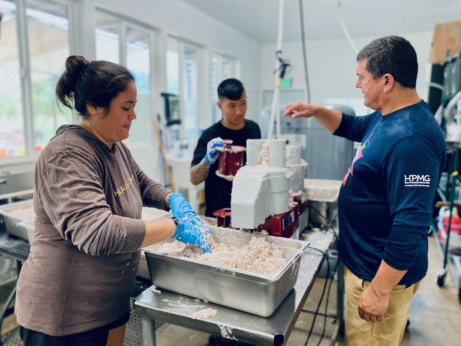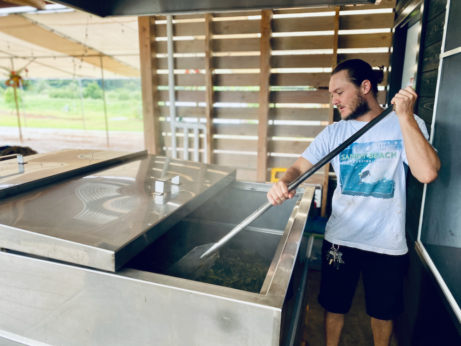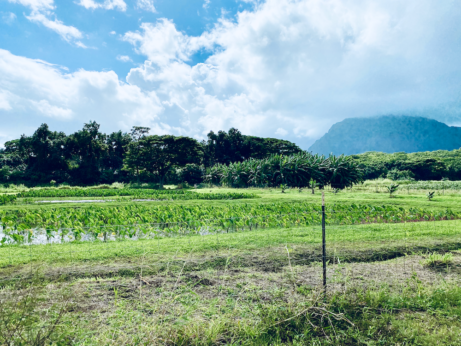Kanekoa Shultz is leading the effort to restore fallowed land into loʻi kalo, the traditional Hawaiian irrigation system used to grow kalo, the Indigenous name for taro.

Sprouting deep within the verdant pleats of Oʻahu’s Koʻolau Mountains, Heʻeia stream winds through Kakoʻo ʻOʻiwi, a non-profit organization centered on a six-acre taro farm, before emptying into the wide mouth of Kane‘ohe Bay.
In 2001, executive director Kanekoa Shultz, a marine biologist and seaweed expert, helped rebuild the adjacent Paepae o Heʻeia fishpond. Originally constructed by Native Hawaiians hundreds of years before colonization, the effort resurrected a 1.3-mile rock-walled lagoon used for aquaculture. Yet, when heavy rains repeatedly choked the basin with sediment, Shultz realized that the pond was but one piece of a larger ecosystem in dire need of rehabilitation.
Six years later, Shultz went on to establish Kakoʻo ʻOʻiwi (the name roughly translates to “Helping Native Hawaiians”) on an untended, 405-acre parcel located directly across from the fishpond. Since then, he’s led the incremental effort to restore the fallowed land into loʻi kalo, the traditional Hawaiian irrigation system used to grow kalo, the Indigenous name for taro.
Enlisting a staff of 16 and an army of volunteers, the organization cultivates the crop in knee-deep water diverted from Heʻeia stream. In addition to supplying the community with fresh corms and spinach-like leaves high in calcium and fiber, an on-site kitchen churns out value-added products such as poi, or taro pounded into a starchy staple, and kulolo, a traditional pudding sweetened with coconut milk and raw sugar.
Kakoʻo Oʻiwi’s efforts, however, extend far beyond promoting Native farming traditions and nourishing the community. Its farming practices also help re-establish a vital ecological role: The irrigated ponds absorb floodwater and filter sediment flowing to the sea while the crops create wildlife habitat and curb invasive plant growth. As stewards of both island culture and terrain, “we’re restoring pono—restoring balance to the land,” says Shultz.

Shultz (right) leads volunteers in shredding taro. (Photo: Naoki Nitta)
Funded largely by private and community donors, it’s a tall order for the scrappy non-profit, which operates under a 38-year lease granted by the state in 2009. The focus on conservation, however, is imperative, he adds, for undoing decades of neglect and mitigating the challenges of a rapidly changing climate.
Heavy, angry water
As a primary food source, kalo holds a reverent place in Native Hawaiian culture, playing a prominent role in its origin story. Before the prevalence of large-scale, Western agriculture, “every valley that had a stream had a kalo plantation,” says Derek Kekaulike Mar, as he helps peel piles of raw taro tagged for a batch of kulolo. A childhood friend of Shultz’s, the frequent volunteer works for a subsidiary of the Hawaiian Native Corporation, a Native-run, nonprofit community impact organization and a Kakoʻo Oʻiwi donor.
Hawaiians traditionally divided land into ahupuaʻa, or self-sustaining units of agricultural production that stretch between the mountains and the ocean. Along with taro patches, the triangular swaths encompassed a range of terrain, from upland timber forests to rain-fed crop fields and orchards in the lowlands. And in many places, they extended to a fishpond—ancient Hawaiians built nearly 500 throughout the islands—with all the pieces connected by a stream.
Recent research has shown that this agricultural system, while only consuming six percent of land, allowed the islands to be self-sufficient in feeding an estimated pre-colonial population of 1.2 million. The study, which was conducted through Kamehameha Schools, a private school system dedicated to educating children with Hawaiian ancestry, concludes that the same methods could feed 86 percent of the state’s current population of 1.4 million—a striking finding for an archipelago that now imports nearly 90 percent of its food while exporting 80 percent of its crops.

Staff member and Farmer Specialist Nick Reppun steams loʻi. (Photo: Naoki Nitta)
Within each ahupuaʻa, a network of taro ponds functioned as surrogate wetlands, regulating the flux of water and removing contaminants flowing downstream. “So the health of the kalo is an indicator of health for the whole ecosystem,” Mar explains.
Colonization and the imposition of private land ownership created seismic shifts in both Native culture and the landscape. As large-scale sugarcane and pineapple plantations began flourishing in the mid-19th century, they consumed land by the tens of thousands of acres and siphoned water supplies, eventually drying up the majority of loʻi kalo throughout the islands.
In the ahupuaʻa of Heʻeia, numerous taro fields had laid fallow since the 1940s, until Kakoʻo Oʻiwi began restoration. Those efforts, however, are integral to a greater system: They bridge the work of Papahana Kuaola, an educational non-profit that keeps upstream waters and forests free of debris and invasive, non-native flora, with the working fishpond located downstream.
Together, the triad works to maintain a clean water supply for the estuary while nourishing a range of Native crops. Besides kalo, both inland organizations cultivate ulu (breadfruit), sweet potatoes and bananas, while the ponds nurture herbivorous fish such as ‘ama’ama (striped mullet), awa (milkfish) and pualu (surgeonfish), as well as crab and shrimp.

Loʻi kalo at Kakoʻo ʻOʻiwi. (Photo: Naoki Nitta)
The traditional agricultural system also supports native fauna, including the endangered ‘alae ‘ula (Hawaiian moorhen). The red-beaked waterbird, whose population hovers around 1,000, nests in taro patches, making the loʻi kalo a crucial habitat.
Increasingly erratic weather patterns have also made taro farming central to maintaining the health of the ecosystem. The past eight years have brought “more rain bombs,” says Shultz. While rain falls with less frequency, each storm carries more volume, upping the potential for “heavy, angry water.”
Because flood pulses suffocate the estuary, the health of the fishpond and reef beyond is directly dependent on the filtration system, says Shultz. Moreover, kalo fields are remarkably effective at absorbing floodwater. “One acre can bank about a foot of water,” he says. “If you multiply that over a hundred acres—that’s over 30 million gallons of water [banked] per rain event.” Achieve that, and “now you’re actually starting to create some [meaningful] climate adaptation.”
Building a balanced system
Currently, the 50 acres of fields yield approximately 600 pounds of taro a week. Although Shultz’s goal is to triple production, scaling up has its challenges: Cultivation is a year-round, labor-intensive job that involves planting 1,000 bulbs weekly, in standing water, and harvesting an equal amount.
In addition to selling poi and kulolo, the farm is diversifying its revenue stream by incorporating non-traditional practices. “We’re taking care of the land that’s sustained us for thousands of years—in a contemporary system,” says Shultz. “It’s a balance,” much like him, he adds—a Native Hawaiian and a blend of other ethnicities. Along with a mushroom-growing facility in the works, he’s added high-value timber such as mahogany trees; 90 heads of sheep that mow down weeds and other invasive plants; and pigs that consume food and crop scraps such as tough and hairy taro peels. “We’ll be eating those buggers soon,” he says of the livestock. “We sell them, we trade them, we give them away.”
Despite these endeavors, the non-profit currently remains 90 percent dependent on grants. Still, “the biological returns far outpace our agricultural revenues,” says Shultz, and the investment in the land extends far beyond the reaches of the ahupuaʻa.
Between food sovereignty, climate resilience and reviving cultural practices, “you can put all kinds of labels” on these efforts, says Shultz. But, ultimately, they all support one goal: “It’s the ability for us to determine our own future.”